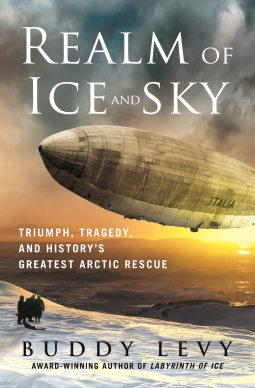
Realm of Ice and Sky
Triumph, Tragedy, and History's Greatest Arctic Rescue
by Buddy Levy
This title was previously available on NetGalley and is now archived.
Send NetGalley books directly to your Kindle or Kindle app
1
To read on a Kindle or Kindle app, please add kindle@netgalley.com as an approved email address to receive files in your Amazon account. Click here for step-by-step instructions.
2
Also find your Kindle email address within your Amazon account, and enter it here.
Pub Date Jan 28 2025 | Archive Date Feb 11 2025
Talking about this book? Use #RealmOfIceAndSky #NetGalley. More hashtag tips!
Description
Two-time National Outdoor Book Award-winning author Buddy Levy's thrilling narrative of polar exploration via airship―and the men who sacrificed everything to make history.
Arctic explorer and American visionary Walter Wellman pioneered both polar and trans-Atlantic airship aviation, making history’s first attempts at each. Wellman has been cast as a self-promoting egomaniac known mostly for his catastrophic failures. Instead he was a courageous innovator who pushed the boundaries of polar exploration and paved the way for the ultimate conquest of the North Pole—which would be achieved not by dogsled or airplane, but by airship.
American explorer Dr. Frederick Cook was the first to claim he made it to the North Pole in 1908. A year later, so did American Robert Peary, but both Cook’s and Peary’s claims had been seriously questioned. There was enough doubt that Norwegian explorer extraordinaire Roald Amundsen—who’d made history and a name for himself by being first to sail through the Northwest Passage and first man to the South Pole—picked up where Walter Wellman left off, attempting to fly to the North Pole by airship. He would go in the Norge, designed by Italian aeronautical engineer Umberto Nobile. The 350-foot Norge flew over the North Pole on May 12, 1926, and Amundsen was able to accurately record and verify their exact location.
However, the engineer Nobile felt slighted by Amundsen. Two years later, Nobile returned, this time in the Italia, backed by Prime Minister Benito Mussolini. This was an Italian enterprise, and Nobile intended to win back the global accolades and reputation he believed Amundsen had stripped from him. The journey ended in disaster, death, and accusations of cannibalism, launching one of the great rescue operations the world had ever seen.
Realm of Ice and Sky is the riveting tale of the men who first flew the most advanced technological airships of their time to the top of the world, risking and even giving their lives for science, country, and polar immortality.
Advance Praise
Praise for Buddy Levy:
"Levy writes beautifully about the cold. His Arctic is fearsome and sublime, his ice a living thing. His passion for this alien landscape is infectious―something to appreciate from underneath a pile of blankets while wearing very warm socks." ―New York Times Book Review on Empire of Ice and Stone
“The gripping account of a fatal polar adventure. Hair-raising suffering and heroism in the Arctic.” ―Kirkus Reviews on Empire of Ice and Stone
"Full of evocative descriptions, harrowing action scenes, and incisive character sketches, this is a worthy addition to the literature of Arctic exploration." ―Publishers Weekly on Empire of Ice and Stone
"[Levy] is a master storyteller whose latest thoroughly researched, spellbinding narrative is both profoundly horrifying and heroic...His well-paced, captivating writing is chock-full of vivid imagery and description, making a gripping true tale all the more haunting, powerful, and hard to put down...an intense and riveting read." ―Washington State Magazine on Empire of Ice and Stone
"Levy tells the incredible tale of the genius of Bartlett leading his unseasoned crew over the ice to Wrangel Island in the dead of winter, and then of his own desperate 700-nautical-mile journey over the ice to Siberia to try to find help to rescue the survivors, vividly bringing this harrowing tale to life." ―Explorers Journal on Empire of Ice and Stone
Available Editions
| EDITION | Other Format |
| ISBN | 9781250289186 |
| PRICE | $32.00 (USD) |
| PAGES | 304 |
Available on NetGalley
Featured Reviews
 Lisa N, Reviewer
Lisa N, Reviewer
My thanks as always goes to St. Martin's Press, and Buddy Levy.
How do.I love thee? Nah, I ain't counting the ways!
Mr. Levy rocks my socks off. I've yet to read something from him that I could call a stinker!
Buddy Levy is NOT a stinker!
I've been reading this author and his books for a few years now, and when it comes to authenticity? Mr. Levy has my attention.
In truth, I can honestly state that I am afraid of Mr. Levy finding new "hunting" grounds. Only because he's so good at what I love.
 Jonathan N, Reviewer
Jonathan N, Reviewer
National Outdoor Book Award-winning author Buddy Levy's thrilling narrative of polar exploration via airship―and the men who sacrificed everything to make history. This is so beautiful resources to know about Arctic.
I love a book that reads as a detailed museum tour for an amazing history of many attempts to conquer a journey to the North Pole, historical accomplishment and real adventures that meant putting their life's on the line. It's a book that straights up some historical facts and an essay on the entire history of attempts instead of just focusing on one atrempt.
Breaking records, failures that became knowledge so the next attempts could improved.
I love anything related to exploration, nature vs. men. This is a great read (also something my father will love).
I like that we get enough detail not only of the journeys, the facts/knowledge of what was fake or real, the details of their families relationships, the participation of others, being presidents or commom men.
Thank you publisher and netgalley for this e-arc.
 William d, Reviewer
William d, Reviewer
– Buddy Levy’s newest history of polar exploration, “Realm of Ice and Sky,” is excellent. Having written “Labyrinth of Ice” and “Empire of Ice and Snow” about expeditions to reach the North Pole by ship, he now turns to the various attempts during the years 1905-1930 to reach it, and to survey Arctic seas, by dirigible airship.
His book tells the story of three men:
1) American journalist and explorer Walter Wellman who was the first to attempt to reach the North Pole by air aboard the dirigible "America" during the years 1907-09;
2) Norwegian polar explorer Roald Amundsen, who already had been first to reach the South Pole, and who would be first to reach the North Pole aboard the airship "Norge" in 1926; and
3) Italian airship designer Umberto Nobile, who designed the Norge and flew with Amundsen, only to fall out with and try to outdo the Norseman by developing a larger and more advanced dirigible, "Italia," which crashed onto the arctic ice in 1929, touching off an ordeal of survival and an unprecedented world-wide, multi-national rescue effort.
It is a tale of adventure, ambition, competition, national pride, perseverance in the face of overwhelming hardship, heroism, jealousy, inventions on the cutting edge of that era’s technology, and the many perils inherent in arctic exploration. It is also a work in which Mr. Levy examines and seeks to “set the record straight” as to who accomplished what in the field of polar exploration, and whether the reputation each explorer earned at the time was correct and fair.
All in all, a great book for anyone who enjoys tales of adventure and survival, polar exploration, international rescue missions, and/or airships and their past and future uses.
My thanks to NetGalley, author Buddy Levy, and publisher St. Martin's Press for providing me with a complimentary ARC. The foregoing is my independent opinion.
Profiteering from Failing to Reach the North Pole
The “Prelude” refers to events that happened between 1900-3. It explains that in the early days of “free-floating balloons” rich people were paying as much as “100,000 francs” for the engineering of ships that could fly as few as seven miles in 30 minutes. Meanwhile, the Wright brothers were developing their flying vehicles by 1903. The “Prologue” reports it is describing events that took place on September 2, 1907 in Danes Island, Spitsbergen. But then recollections jump back to events in 1897. Wellman’s connection to President Roosevelt is puffed. There is a description of Wellman’s flight that took place in 1907, which was designed to be a 1,500-mile flight, despite this being this balloon’s “maiden voyage”. Apparently, when a Brazilian won the 100,000 francs prize in 1901, Wellman began planning this 1907 voyage on a “motorized airship” In “Part One: The Pioneer: The Remarkable Walter Wellman”. Wellman is described as an “American journalist” who “boarded the airship America at Danes Island in 1907… to fly into… polar exploration immortality…” Information about where Wellman was born and details on the expedition follow. He had been “obsessed with being the first to reach the North Pole”, taking expeditions northward between 1884-1907. Initially, he tried taking a ship. In the first attempt, “his hired ship the Ragnvald Jarl was crushed by giant fangs of ice and sunk”. After two months of desperate travel, they were rescued by a Norwegian sealing vessel. Then he took a trip in 1898. He had left two sailors in their base camp, before setting out to explore. While they were away, one of these two died, and the other slept with his dead body in his hut for 2 months. After burying the guy, despite his wishes not to be buried to avoid being eaten by animals, Wellman finally set out on a 700-mile “trek for the North Pole”. On this trip he “fractured his leg in an ice crevasse”, so he had to be “carried on a sled” for weeks. They only reached the inhabited “camp at Cape Tegetthoff”, after all that effort, where they stayed at a furnished house, with the main fear being that Wellman’s foot would be amputated. He had so far achieved absolutely nothing new, as he had not gone further than well-trodden paths. He had the money to keep at this absurd attempt because he had profited from starting The Penny Paper in Cincinnati, Ohio in his 20s, later selling it at a profit.
In my research into British ghostwriting, I learned that most travelogues of early British exploration were fictions that were written to “conquer” territories before it was actually feasible for merchants to venture into them. For example, after puffing “Dampier’s” voyages, investors and migrants could more easily be found with this travelogue to in fact settle in the described places. Many travelogues with nature-exploring themes were covering for slave-capturing or colonial missions or piratical or privateering captures of enemy nations wealthy-laden ships. There tended to be some hidden investor who would sponsor the ghostwriting, publication, and advertising of such travelogues, who profited from puffing the specific narrative being glorified. This is how the Brits “discovered” and put a flag on most of America centuries before they even traveled across most of it. Thus, I am very skeptical regarding just how this Wellman was profiting from these trips, and just why he kept trying or reporting to have tried.
Wellman had $250,000 ($8 million “in today’s currency”) in funding for his 1905 airship attempt. His main funder was Lawson, a Chicago Norwegian-language newspaper publisher, who invested $75,000. The rest came from “telephone inventor Alexander Bell and the National Geographic Society” (28-9). The ship was built and he attempted a failed voyage (after at least one self-destructing explosion) in 1907. He tried again without new funding in 1909, and was again stopped by mechanical failures. By Part Three, events take place in 1927-8. This got me interested in the money of it all, so I searched for “$”. Wellman had fired his “original hangar… on Danes Islands” after he had engineered much of the expensive ship. This designer, Alexander Liwentaal, was publishing critical articles about Wellman in the Parisian journal, so Wellman filed a libel lawsuit against him in 1907 (71). Wellman needed to crush all criticism because he was being promised enormous sums for a puffed narrative of discovery. Specifically, in 1910, the “editor of Hampton’s Magazine” was offering, if Wellman succeeded “$75,000 to $100,000 for world rights to the magazine story….” And all together up to $1 million (100). Wellman was conning most of the folks he met out of money, talking an Ohio father into investing $85,000 (129). He spent most of this money on just purchasing a ship, instead of spending more money to build it himself; he had tried just firing an engineer and not paying him fully on the previous occasion, but that had not worked out, as it seems his libel suit was unsuccessful. This is pretty much all the mentions of money in this book. But if there had been more, this would have been a book about the great scammer who managed to keep convincing investors who give him money. He seems to have deliberately made impossible goals, which nobody was surprised failed. He didn’t have to try too hard in these attempts, since investors would have no recourse to argue given extreme risk. He could have been intentionally spending time at the nearest village without trying to reach the North Pole, and collecting millions for trying. Perhaps, he insured some voyages and then deliberately drove ships into icebergs to give a return to investors who were otherwise failing to see a profit from these. I just don’t believe the surface claims of this narrative, and I think something very suspicious was going on.
That said, this is a fun read, as both the surface and the subversive versions are outrageously adventurous, as the characters take on strange challenges, and take unexpected actions. This is a good book both for researchers and casual readers. And various types of libraries should welcome it into their collections.
--Pennsylvania Literary Journal, Summer 2024 issue
First, I must genuinely thank NetGalley and St. Martin’s Press for the ARC of Buddy Levy’s gripping epic “The Realm of Ice and Sky.” Always keeping up with his latest works, I was honored to read the next incomprehensible story of Artic exploration.
Levy’s narrative is beautifully constructed into three entirely different, yet related accounts of Artic exploration and rescue. The reader is riding passenger for these daring adventures of flight, yes flight, to and over the North Pole in the early 20th century. A sense of doom looms large and eerily close throughout the entire story, keeping the reader gripped to the edge of their chosen reading spot as if sitting in the seats of one of the dubious flying machines.
Carefully researched, with “The Realm of Ice and Sky,” Buddy Levy depicts an unforgiving, powerful landscape that drew some of the world’s greatest explorers and bonded them in an ultimately deadly quest for discovery.
I’ll be adding it to my bookshelves as soon as it hits stores. Well done.
Readers who liked this book also liked:
Megan Ashley Smith, LCMHC, NCC
Health, Mind & Body, Nonfiction (Adult), Self-Help
Jennifer Chiaverini
General Fiction (Adult), Parenting & Families, Women's Fiction


















